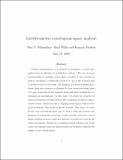Interferometric correlogram-space analysis
Author(s)
Poliannikov, Oleg V.; Willis, Mark E.; Mashele, Bongani Jabulani
Downloadpoliannikov_2009.pdf (923.1Kb)
Other Contributors
Massachusetts Institute of Technology. Earth Resources Laboratory
Metadata
Show full item recordAbstract
Seismic interferometry is a method of obtaining a virtual shot
gather from a collection of actual shot gathers. The set of traces
corresponding to multiple actual shots recorded at two receivers is
used to synthesize a virtual shot located at one of the receivers and
a virtual receiver at the other. An estimate of a Green’s function between
these two receivers is obtained by first cross-correlating pairs
of traces from each of the common shots and then stacking the resulting
cross-correlograms. In this paper, we study the structure of
cross-correlograms obtained from a VSP acquisition geometry using a
surface source reflected by flat or dipping layers and/or diffracted by
point inclusions. The model is purely acoustic. The shape of events
in the cross-correlogram space can be used to infer the location and
geometry of a subsurface structure. A pilot wavelet created by a curvilinear
stacking process is used as a detector of predicted events in the
cross-correlogram. Results of a semblance-based velocity scan of the
cross-correlograms using curvilinear stacks can be used to improve the
quality of the virtual gather.
Date issued
2009-05-31Publisher
Massachusetts Institute of Technology. Earth Resources Laboratory
Series/Report no.
Earth Resources Laboratory Industry Consortia Annual Report;2009-08
Keywords
Interferometry, Imaging